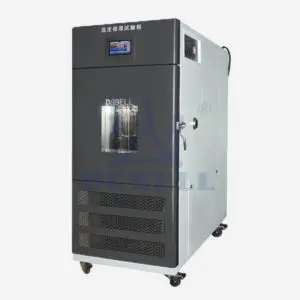With the development of science and technology, the requirements for the reliability of electronic components are getting higher and higher. Especially in aviation, aerospace and other applications. In general, in order to meet the reliability requirements of the project, a series of environmental tests are performed to verify the reliability of the component during the period from production to delivery.
Mechanism of Temperature Cycling Test
Principle of Temperature Cycling Test
The temperature cycling test mainly USES the difference of thermal expansion coefficient of different materials to test. The main purpose is to strengthen the thermal stress caused by the rapid change of temperature on the deterioration of the specimen. As the electronic component undergoes a temperature cycling, the interior expands and contracts alternately. And make it produce thermal stress and strain.
If the thermal expansion coefficient of the adjacent material inside the assembly does not match. These thermal stresses and strains intensify. Potential defects will play the role of stress increase, with the continuous application of temperature cycling. Defects grow up and eventually become faults (such as cracks) and are found. This is called thermal fatigue.
Temperature Rise and Fall Principle of Temperature Cycling Test
Temperature cycling test The temperature rise and fall is generally achieved by cold or hot air circulation heating or cooling in a single temperature cycling chamber. The effectiveness of the temperature cycling chamber used in the test has a great impact on the accuracy of the test results. The method of adjusting the temperature by the temperature cycling chamber is to use a temperature sensor to measure the temperature of the air or the test piece in the chamber. After the signal is converted, the controller compares the set value with the controller. The result of the comparison determines whether the heating system or cooling system is operating and is adjusted to the required temperature. There is usually a fan in the temperature cycling chamber to force the convection to make the temperature at each point in the chamber as uniform as possible.
For battery products, because the test piece is composed of a variety of different materials, its mechanical properties are also very different. Among them, mechanical properties include Young’s coefficient, yield strength, thermal conductivity coefficient, thermal expansion coefficient and so on. Therefore, when the temperature of the test piece changes, due to the different temperature values, related geometric dimensions, material coefficients, structural arrangements, etc., the stress and strain values they receive will also be different.
- Temperature range
- Number of cycles
- Holding time
- Temperature change rate
- Wind speed
These key parameters are analyzed separately below.
Temperature Range
The temperature range is the difference between the high and low temperature limits. In principle, the larger the temperature range, the better. However, the actual situation depends on the heat resistance of electronic products. Through the analysis of heat transfer characteristics, we can understand the distribution and change of internal temperature of the product under different temperature ranges. The analysis of heat transfer characteristics can be analyzed by theoretical models or directly measured by actual conditions.
In actual work, it is more convenient to use the measurement method. However, pay attention to whether the product needs to be powered up when measuring. Because when the power is on, the product temperature will change, especially for high-power electronic products. After understanding the distribution and change of the internal temperature of the product under various temperature cycling conditions, you can choose the maximum temperature range without damaging the normal product.
Number of Cycles
As temperature alternations cause mechanical stress in the specimen, the internal stress of the specimen increases with the increase of temperature alternations. In theory, the more cycles, the more acceleration. But in fact, too many times may affect the service life of the product.And it increases costs. Therefore, it is common to refer to previous experience or related specifications to select an appropriate number of cycles. The better cycle times were found by test analysis.
Holding Time
The holding time depends on the thermal equilibrium time when the test sample reaches the ambient air temperature. The retention time of the specimen should be selected according to the thermal time constant of the specimen. For larger products, the thermal time constants of the interior and surface may differ greatly, and the thermal time parameters of the innermost or most vulnerable parts should be selected to determine.
Temperature Change Rate
Generally speaking, the higher the temperature change rate, the better the testing effect. However, due to the influence of the wind speed in the heat cycling chamber and the thermal capacity of the specimen, the temperature response of the specimen is not consistent with the thermal output of the heat cycling chamber. The results show that the test strength of temperature cycling does not always increase with the increase of temperature change rate. When the temperature change rate reaches a certain value, increasing the temperature change rate has little effect on the environmental stress test. At this point, the specimen is insensitive to temperature changes. The temperature change of specimen lags behind that of test chamber obviously.
Wind Speed
The wind speed is closely related to the parameters of the temperature cycling test. And it has a great influence on the temperature rise and fall curve of the temperature cycling chamber. In addition, higher wind speeds can achieve higher temperature variances. Moreover, the temperature uniformity of the specimen can be improved.
Summary
Among various commonly used environmental screening stresses, the screening cycle temperature is the most effective. Our company’s temperature cycle test chamber meets the following standards:
- IEC62133
- UL1642
- UN38.3

